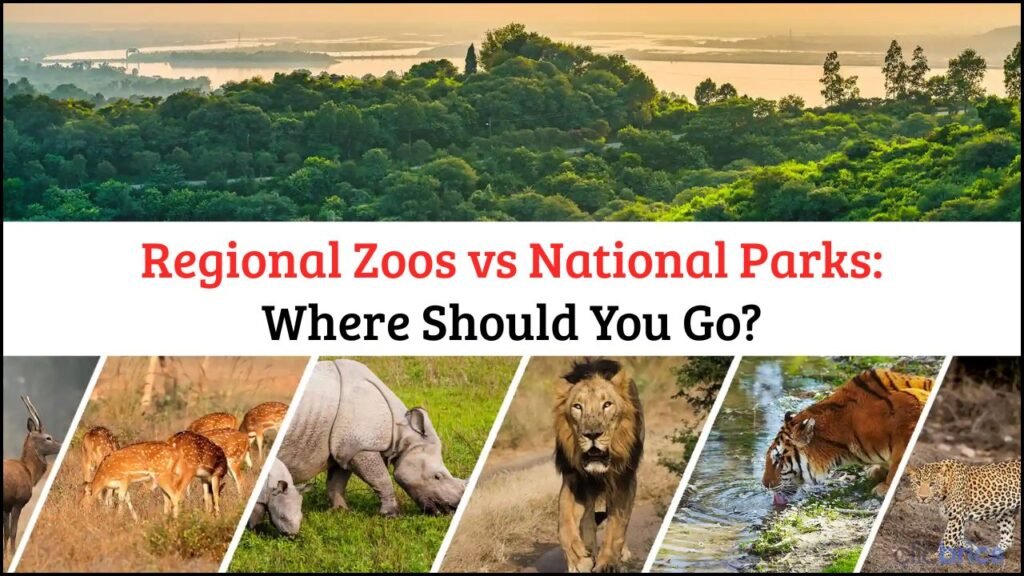
Choosing between a regional zoo and a national park can be a tough decision for nature lovers. Each offers a unique experience based on what someone wants to see and learn. Regional zoos offer close-up animal encounters, while national parks provide open natural spaces and wild ecosystems. Understanding the differences between the two helps people plan more meaningful trips with their families or friends.
Table of Contents
Regional Zoos: Controlled Environments with Educational Value
Regional zoos are designed to provide safe, up-close experiences with animals from different parts of the world. These zoos often focus on conservation, education, and family engagement.
- Animal Access: Animals can be seen closely, making it easier for people, especially children, to learn about them.
- Education Programs: Zoos offer talks, guided tours, and interactive displays to teach visitors about species and conservation.
- Conservation Efforts: Many zoos participate in breeding programs to help protect endangered species.
- Accessibility: Zoos are usually located in or near cities, making them easy to reach.
- Facilities and Comfort: Benches, restrooms, food stalls, and shaded areas provide comfort during visits.
- Artificial Habitats: Animals live in enclosures that simulate their natural environment but may limit their space and behaviors.
- Ticket Prices: Entry is affordable and often includes group discounts or annual passes.
National Parks: Natural Beauty and Wildlife in the Wild
National parks offer a completely different experience. They preserve large landscapes and allow animals to roam freely in their native habitats.
- Wildlife in Natural Settings: Visitors may spot animals like deer, tigers, bears, or birds in their natural surroundings.
- Adventure Opportunities: Trekking, camping, bird-watching, and photography make trips exciting and memorable.
- Uncontrolled Environment: Animals are not guaranteed to appear, making each visit unpredictable but thrilling.
- Large-Scale Ecosystems: National parks protect forests, rivers, and mountains along with the wildlife.
- Limited Facilities: Fewer rest areas, food options, and amenities are available compared to zoos.
- Educational Value through Experience: Observing animal behavior in the wild teaches respect for nature and ecosystems.
- Higher Travel and Entry Costs: Reaching parks might involve long travel and entrance fees, sometimes including vehicle charges.
Key Differences Between Regional Zoos and National Parks
| Feature | Regional Zoos | National Parks |
|---|---|---|
| Location | Within or near urban areas | Remote or protected natural locations |
| Animal Interaction | Close-up views in controlled habitats | Distant and often rare wildlife sightings |
| Accessibility | Easy to access by car or public transport | Requires travel and planning |
| Conservation Role | Breeding and species preservation | Habitat and ecosystem protection |
| Visitor Comfort | High, with many visitor amenities | Moderate to low, basic facilities only |
| Educational Approach | Talks, signs, and zookeepers | Natural observations and ranger guidance |
| Adventure Level | Low, suitable for all age groups | High, often includes physical activities |
| Cost of Visit | Lower, affordable for families | Higher due to entry fees and travel expenses |
Which One is Right for You?
Family with Young Children
- Regional zoos suit families with small kids because of safety, stroller-friendly paths, and short walking distances.
Nature Enthusiasts and Photographers
- National parks are ideal for people looking for scenic views, wild animals in natural habitats, and adventure.
Educational School Trips
- Zoos provide structured lessons, ideal for school groups learning about animal biology.
Eco-Tourists
- National parks align with eco-tourism goals like sustainability and nature conservation.
Budget Travelers
- Zoos offer low-cost outings with full-day entertainment within city limits.
Thrill Seekers
- National parks challenge visitors with rugged paths, dense forests, and unexpected animal sightings.
Advantages of Visiting Regional Zoos
| Benefit | Explanation |
|---|---|
| Safety | Fenced areas and staff monitoring ensure secure experiences. |
| Variety of Species | Animals from all continents can be seen in one location. |
| All-Weather Visitation | Indoor exhibits and shaded paths allow visits in any season. |
| Short Visit Duration | Half-day trips are enough for a complete experience. |
Advantages of Exploring National Parks
| Benefit | Explanation |
|---|---|
| Natural Exploration | Real ecosystems help people connect deeply with nature. |
| Physical Activity | Hiking and trekking support health and fitness. |
| Biodiversity | Unique species, both plants and animals, can be found. |
| Silence and Peace | Natural settings provide quietness away from city life. |
Disadvantages to Consider
| Location Type | Disadvantage | Details |
|---|---|---|
| Regional Zoo | Limited animal behavior | Animals behave differently in captivity than in the wild. |
| Regional Zoo | Less immersive experience | Artificial surroundings reduce the wild feel. |
| National Park | Risk of not spotting animals | Wildlife may hide or stay distant. |
| National Park | Physical demands and fewer amenities | Long walks and basic restrooms might be difficult for older visitors. |
Final Analysis
Planning a visit to a regional zoo or a national park depends on personal interests, mobility, time, and budget. Regional zoos provide close interaction and are best for quick educational trips. National parks offer freedom, wildness, and unforgettable adventures. Making the right choice ensures a joyful and enriching nature experience for every traveler.





